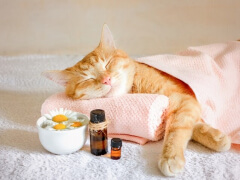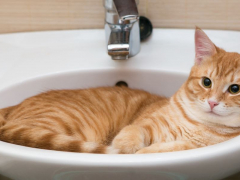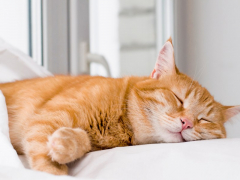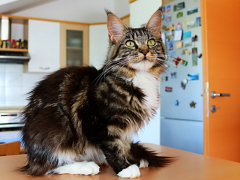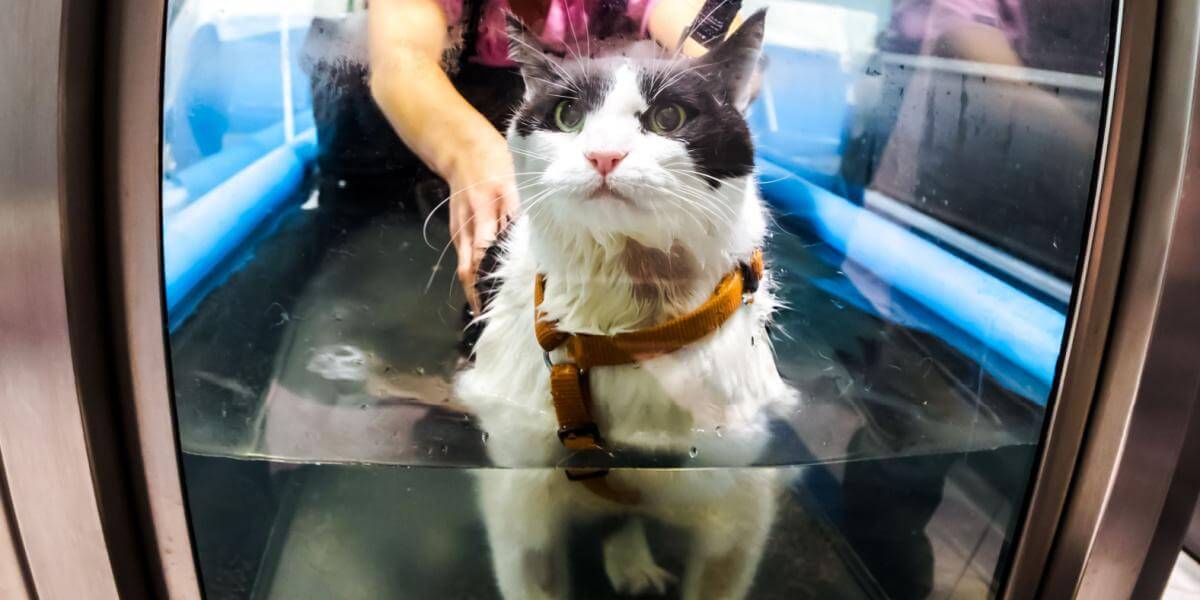
Benny Marty / Shutterstock.com
Hydrotherapy is a widely used form of rehabilitation therapy for dogs that helps them recover from musculoskeletal and neurological conditions. This healing therapy has become essential to veterinary physical rehabilitation for cats who can tolerate it.
Research shows that it provides an excellent environment for conducting non-concussive active exercise, and its natural properties can help improve limb mobility, strength, and joint range of motion.[3].
Let’s explore the world of holistic healing and the wonders of hydrotherapy for cats.
What Is Hydrotherapy?
Hydrotherapy is derived from the Greek “Hydro”, meaning water, and from Modern Latin “Therapia”, which means “Treatment of a disease”. It is a form of alternative medicine that uses water to accelerate physical and mental well-being.
Hydrotherapy involves using warm water in various forms, such as bathtubs, whirlpools, pools, and underwater treadmills. It can help alleviate pain, reduce swelling, and enhance circulation, making it essential for treating various conditions, from postoperative fragmentation, muscle injuries, and arthritis to neurological conditions.
Only certified professionals such as animal physiotherapists, veterinarians, or certified animal rehabilitation veterinary technicians should perform hydrotherapy on pets.
Principles of Hydrotherapy
Understanding the fundamental properties of water that provide therapeutic value to the feline patient is essential.
Buoyancy Provided by the Water
The upward thrust of the water provides buoyancy, meaning an animal in water is less heavy than on land. Feline patients who have weak muscles and painful joints can move more freely in the water with less pain. The effects of buoyancy differ depending on the depth of the water used (Levine et, al, 2004)[7].
Hydrostatic Pressure
When you submerge an animal in water, the water’s pressure expands. Since hydrostatic pressure provides constant force to a limb, it may help reduce swelling and oedema. It can also decrease pain during exercise (Levine et, al, 2004)[7].
Viscosity, Resistance, and Surface Tension
The water viscosity is more significant than air, so water provides resistance to an animal’s body as it moves through it. You can also increase the resistance by utilizing jets to strengthen feline muscles and improve cardiovascular fitness. Resistance to movement is also somewhat more remarkable on the water surface due to the effect of surface tension, which is the tendency of the water molecules to stick to each other. Therapeutically, if a feline patient is weak, it will be easier to balance and move in the water than on land (Levine et, al, 2004)[7].
When Is Hydrotherapy Recommended for Cats?
An animal physiotherapist may recommend hydrotherapy after a physio assessment once they identify your cat’s physical impairment and limitations so that an appropriate treatment plan can incorporate rehab exercises and a hydropathic treatment program.
The aquatic program may require both the water treadmill therapy and the pool or just one piece of equipment, usually an underwater treadmill, as a starting point to ease the patient into the sensation of water exercise.
Here are some common feline conditions a physiotherapist or a veterinarian may recommend hydrotherapy as a treatment option:
- Post-surgery rehabilitation: Very useful in the immediate postoperative period after joint surgery or when a patient exhibits reduced weight bearing on an operated limb.
- Pain management: Water therapy can treat different types of pain (acute and chronic) caused by injury or disease, including post-surgical pain.
- Orthopaedic conditions: Muscle injury, tendinitis, fractures, osteoarthritis, degenerative joint disease (DJD) and hip dysplasia all benefit from water healing.
- Neurological diseases: Spinal injuries, Intervertebral disc disease, Hypotonicity – lower motor neuron lesion and neurological trauma affecting one or both hind limbs.
- Weight loss program: An underwater treadmill provides an ideal setting for overweight or obese cats to exercise and lose weight without placing excessive tension on their joints due to the water buoyancy.
Effectiveness of Hydrotherapy for Cats
Water exercise can be highly beneficial for cats. It can improve mobility, reduce pain and inflammation, and accelerate recovery post-injury or surgery. Moreover, it is an excellent way to provide exercise for felines who may have difficulty moving around due to age or health-related issues.
Hydrotherapy can benefit cats by providing a low-impact water workout; however, its effectiveness may vary depending on the cat’s underlying condition or health issue. Here are a few successful cases of hydrotherapy in cats:
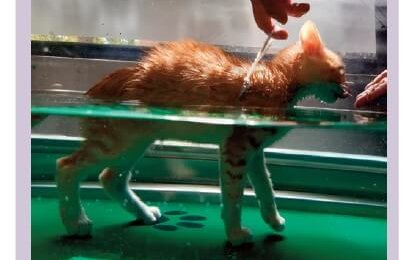
Hershel’s first hydrotherapy session. International Society of Feline Medicine.
Road traffic accidents are common in cats. Someone from the public brought an unowned 4-month-old kitten, suspected of being hit by a car, to the vet clinic in the United Kingdom. He was named Hershel. Radiographs of Hershel revealed multiple fractures of the femur and pelvis.
Hershel underwent surgery to unify the fragments with tension bands. Post-surgery, he was on bed rest, including analgesia and anti-inflammatory medication. Hershel’s rehabilitation treatment consisted of cryotherapy, laser therapy, plus passive and active physiotherapy, including hydrotherapy. Hershel had two sessions a week of hydrotherapy for about 2.5 months (about 18 sessions in total). During this time, he regained his muscle mass independence of movement and recovered his natural gait.
Hydrotherapy was essential in helping Atticus, an 8-year-old domestic short-hair cat client of mine in Australia, lose weight. He underwent 15 hydrotherapy sessions for several months while on a restricted-calorie diet, which resulted in a significant decrease in his weight.
Stephanie Siegrist (CCFT, CCRA) from the Rehabilitation Team at the Animal Rehabilitation Center of Michigan, Inc. shared her anecdotal evidence: “While it can take some special handling and acclimation, we have had several cats do very well with hydrotherapy. We primarily use it for osteoarthritis and weight loss and have seen a few after hip and knee surgeries.”
Duration and Cost of Cat Hydrotherapy Sessions
Typically, each session lasts between 15 to 30 minutes, including preparation, washing, and drying afterward. The length of the workout depends on the facility, location, and the patient’s medical needs. In fractures, it is necessary to undergo two weekly hydrotherapy sessions, including physio for about two months, to regain muscle mass and movement independence.
The cost can range from $30 to $100 per session, depending on the abovementioned factors. Some hydro facilities may offer bundle deals for multiple sessions.
Contraindications and Precautions to Hydrotherapy for Cats
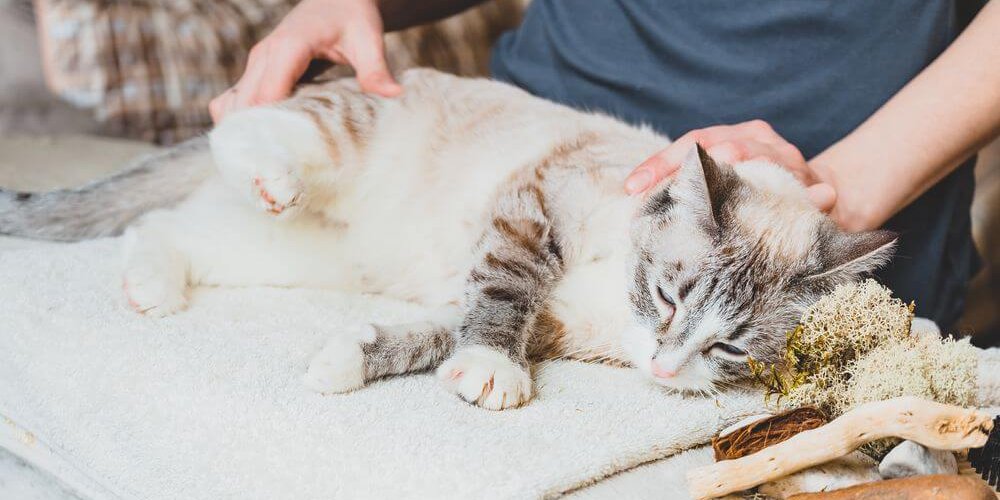
Ekaterina Kuzovkova / Shutterstock.com
While hydrotherapy can be beneficial for cats, it is essential to be aware of specific contraindications and precautions. It should not be used on cats with open wounds, infections, or skin diseases, as it may hinder healing and increase the risk of complications. Ideally, hydrotherapy should start 48-72 hours after surgery, although dogs usually begin 2-3 weeks post-surgery.
Additionally, cats with fecal incontinence or diarrhea, respiratory problems, significant cardiovascular issues, or fear of water should avoid aquatic physical activity. Safety is crucial for hydrotherapy, and the rehabilitation team should take necessary precautions.
Consider the following safety measures:
- Medical examination: Individuals must undergo a thorough medical assessment to identify any contraindications the treatment may exacerbate.
- Certified supervision: Water inhalation and drowning are genuine risks during aqua therapy. Therefore, a veterinarian or vet tech should always supervise, and the patient must wear an appropriate harness or life vest.
- Water temperature: Maintaining the correct water temperature is crucial. Incorrect temperatures can lead to burns, hypothermia, or discomfort. So, careful monitoring is a necessity.
- Gradual succession through positive experiences: Introduce cats to water slowly by making it a positive experience using favorite toys and treats. The therapist must consider the cat’s acceptance, tolerance, and response to treatment without rushing the process since it may increase your cat’s risk of stress or injury.
- Hygiene and disinfection: The underwater treadmill, pool, and all other equipment must undergo rigorous cleaning and disinfection to prevent the spread of diseases and ensure a hygienic environment.
Frequently Asked Questions
Can all cats undergo hydrotherapy?
Certain breeds are more accepting of water than others. Breeds such as Turkish Van, Siamese, Norwegian Forest Cat, Burmese, and Bengals are more comfortable with water. However, successful aquatic therapy in feline patients requires a thorough understanding of cat behavior and excellent handling skills by the rehab technician or vet nurse. It's also crucial for the guardian and nurse to reassure the cat during the treatment.
How should I prepare my cat for hydrotherapy?
Preparing a cat for hydrotherapy involves several steps. Ideally, a behaviorist must employ behavior modification techniques to help the cat become comfortable with the process. Additionally, the cat must learn to wear a harness or life jacket. It may be helpful to accustom the cat to bathing and drying at home to help overcome water aversion, which will aid in the gradual progression from bathing to hydrotherapy sessions.
What are the disadvantages of hydrotherapy?
Hydrotherapy's drawbacks include cost and time commitment, especially if multiple rehabilitation sessions are needed. Additionally, it may not be accessible in rural or remote locations. Although rare, potential adverse reactions include skin irritation, infection, or discomfort during the treatment.
-
Sharp B. Feline Physiotherapy and Rehabilitation: 1. Principles and potential. Journal of Feline Medicine and Surgery. 2012;14(9):622-632.
-
Sharp B. Feline Physiotherapy and Rehabilitation: 2. Clinical application. Journal of Feline Medicine and Surgery. 2012;14(9):633-645.
-
Bliss, M., Terry, J., & De Godoy, R. F. (2022). Limbs kinematics of dogs exercising at different water levels on the underwater treadmill. Veterinary Medicine and Science, 8(6), 2374–2381.
-
Kim L. Jacobsen, Valerie Wiebe, Autumn P. Davidson, Brian G. Murphy, Jr. Roy R. Pool, Use of Enrofloxacin and Hydrotherapy in the Management of Fibrodysplasia Ossificans Progressiva (FOP) in a Savannah Cat, Topics in Companion Animal Medicine, Volume 52, 2023, 100757, ISSN 1938-9736.
-
Goldberg, M. E. (2016, October 11). Feline Physical Rehabilitation. Retrieved November 25, 2023, from Today's Veterinary Nurse.
-
Today’s Veterinary Nurse. (2022, January 11). Feline physical rehabilitation.
-
Canine Rehabilitation and Physical Therapy - 2nd Edition. (2013, October 24).



